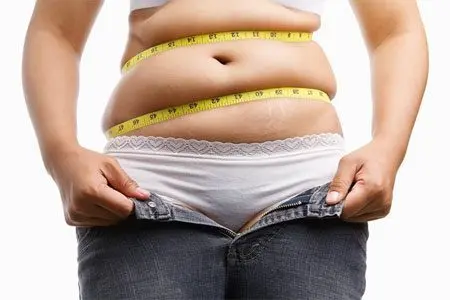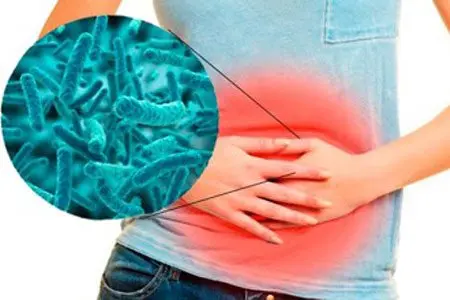Contents

Fat deposits in the abdomen are very dangerous to health. Excess weight can provoke the development of serious diseases: metabolic syndrome, type II diabetes, heart disease, malignant tumors.
The term “visceral fat” is used to define abdominal fat localized in the abdominal cavity, around the internal organs. It can form in the liver, kidneys, digestive organs, displace the diaphragm, and compress blood vessels.
Sometimes it happens that a person has extra deposits around the abdomen, but the total weight remains within the normal range. This state of affairs cannot be considered safe. All the adverse risk factors for excess fat remain.
There are 12 things that make you gain weight.
1. Sweet foods and drinks

Most people consume a lot more sugar every day than they think. Foods high in sugar include sweets, cakes, sodas, flavored coffees, sweet teas. Even “healthier” foods like muffins, frozen yogurt, are potentially dangerous.
Clinical observations have shown the relationship between excessive sugar intake and the formation of body fat. This is due to the high content of fructose in dietary sugars. The usual sugar, corn syrup is characterized by a high content of fructose. Sugar is a disaccharide composed of 50% glucose and 50% fructose. Corn syrup contains 55% fructose.
In one study, overweight subjects consumed 10% of daily calories from fructose drinks for 25 weeks while following a weight loss diet. The results showed a decrease in insulin sensitivity and an increase in abdominal fat. [1]
The results of the second experiment with similar diet conditions, with a high content of fructose, showed the inhibition of metabolic processes in the body of the subjects, a decrease in fat burning. [2]
Sugar in any form is dangerous for the formation of extra pounds. The biggest problem is carbonated and other drinks sweetened with sugar. This is due to the fact that in a short time the body receives large amounts of sugar.
Dietitians claim that liquid calories do not affect appetite suppression in the same way as calories from solid foods. High-calorie drinks do not make you feel full. During the use of these types of drinks, the body requires more food to satisfy the feeling of hunger.
2. Alcohol

Alcohol has both positive and negative effects on the organs and systems of the human body. For example, the reasonable use of red wine reduces the likelihood of developing heart disease, stroke. A large amount of alcohol leads to inflammatory diseases of the liver, other pathologies of internal organs.
Studies show that alcohol not only inhibits fat-burning mechanisms. Alcohol’s calories are converted to fat and stored at the waist—hence the term beer belly. [3]
In one study, it was found that men who drink large amounts of alcohol have 80% more problems with being overweight than non-drinking men. [4]
Of great importance is the amount of alcohol drunk during the day. The subjects who consumed one glass of alcoholic beverage (about 250 ml) had the smallest amount of abdominal fat. When drinking alcohol 4 or more times more, the risk of weight gain increases.
3. Trans fats
Trans fats are a type of saturated fat that is one of the most unhealthy food components. For greater stabilization, hydrogen molecules are added to the molecules of unsaturated fats. This modification is used to increase the shelf life of products in factory packaging: muffins, crackers, baking mixes.
Trans fat content per 100 g of product:
Product | Trans fat content |
Confectionery fat | 10-33 g |
Margarine | 0,2-26 years |
Butter | 2-7 g |
Whole milk | 0,07-0,1 g |
Bread/cakes | 0,1-10 g |
Cookies and crackers | 1-8 g |
Salty snacks | 0-4 g |
Frosting and candies | 0,1-7 g |
Animal fat | 0-5 g |
Ground beef | 1 g |
When studying the effect of trans fats on the human body, it was found that they provoke inflammatory processes. Excessive consumption of foods containing trans fats leads to insulin resistance, the progression of cardiovascular disorders, and some somatic diseases.
Animal experiments have found that eating a diet high in trans fat leads to excess body fat. For six years, the monkeys were offered foods containing saturated fats. As a result, they gained 33% more visceral fat than individuals fed a monounsaturated fat diet. [5]
4. Passivity

A sedentary lifestyle is one of the unfavorable factors for health. For several decades, there has been a tendency to reduce the activity of both the adult population and children. This fact explains the increase in the number of obese patients of various forms.
In the period from 1988 to 2010, large-scale surveillance of men and women was carried out in the United States. It gave disappointing results: every year the percentage of activity of the population is steadily declining, and at the same time the number of overweight people is growing.
Another stand-alone study followed two groups of women:
Participants who watched TV for more than three hours a day.
Participants who watched TV for less than an hour a day.
The results showed that women in the first group were twice as likely to develop severe visceral obesity than women in the second group. [6]
It has been experimentally proven that a sedentary lifestyle contributes to the restoration of fat accumulation in the abdomen after weight loss. Participants who did aerobics or strength training for a year after losing weight maintained their weight loss and prevented the recovery of abdominal fat. Those who did not exercise after losing weight experienced a 25-38% weight gain. [7]
5. Low Protein Diets

To prevent weight gain, you must follow the rules of a healthy diet, provide the body with high-quality protein. A diet based on the use of protein products gives a feeling of satiety for a long time, boosts the metabolic process, and allows you to consume fewer calories.
Insufficient protein content in the daily diet can cause an increase in belly fat. Observations of nutritionists show that people who adhere to protein nutrition have practically no problems with being overweight. [8]
Experiments involving animals have made it possible to determine that a high level of the hormone neuropeptide Y (NPY) causes an increase in appetite, provokes the deposition of fat in the depot. The amount of NPY depends on the level of protein – the less protein foods in the diet, the more neuropeptide Y our endocrine system produces.
6. Menopause

During menopause, the problem of excess weight worries many women. During puberty, the production of the hormone estrogen begins. It is necessary to prepare the female body for a potential pregnancy. Estrogen promotes the formation of adipose tissue in the pelvis and thighs. Subcutaneous fat of this type is not harmful, it is not difficult to lose it in some cases.
The absence of menstruation within 12 months suggests the onset of menopause. During this period, estrogen production decreases. Hormonal changes cause the accumulation of fat deposits in the abdomen, and not the pelvis and thighs. [9]
Some women have more belly fat than others. The appearance of excess weight is influenced by the age at which menopause began, hereditary predisposition. One medical study found that during early menopause, as a rule, abdominal fat is formed in small quantities.
7. Intestinal dysbacteriosis

The gut microflora or microbiome is represented by hundreds of bacterial species. Their main area of activity is the large intestine. Some intestinal bacteria are good for health, while others can cause certain diseases. Maintaining a healthy gut is important for immunity and disease prevention.
An imbalance in the composition of intestinal bacteria increases the likelihood of developing type II diabetes, heart disease, and cancer. The results of medical research suggest that an imbalance in the intestinal flora can cause an increase in weight and volume of visceral fat.
Examination of overweight patients showed that their intestinal flora contains much more bacteria-firmicutes (Latin – Firmicutes) than in people with normal weight. The vital activity of firmicutes causes a significant consumption of calories obtained from food. [10]
Animal experiments have shown that mice given faecal transplants of the obesity-causing bacteria had more adipose tissue compared to mice given the lean biomaterial.
The study of pairs of twins suffering from obesity, their mothers confirmed the assumption that the composition of the flora in family members is almost identical. This affects the appearance of extra pounds, the deposition of fat in typical places.
8. Fruit juice

Nutritionists characterize fruit juices as drinks with sugar in disguise. Even 100% natural fruit juice contains a lot of sugar. For comparison: 250 ml of apple contains 24 grams of sugar, the same as 250 ml of cola. Grape juice in the same volume contains 32 grams of sugar. In relation to sugars, these figures are catastrophically high.
The rich vitamin and mineral composition does not compensate for the negative effects of fructose. It can cause insulin resistance in the body, contribute to the accumulation of extra pounds on the stomach. [11]
It is important to remember that juices are a source of liquid calories. Absorption of calories in liquid form cannot suppress hunger for a long time. This causes a desire to consume more foods with solid calories.
9. Stress and cortisol

The hormone cortisol is produced to protect against decreased immunity and chronic emotional stress. It’s called the stress hormone for a reason. In an emotionally unstable state, cortisol is released into the blood in large quantities.
Regular cortisol surges can trigger overeating. Since hormone receptors are located in the abdomen, fat is deposited in this area. [12]
One physiological pattern has been noticed, the greater the ratio of waist to hips, the more cortisol is released into the blood during stressful situations.
10. Fiber deficiency

Fiber is one of the main components for maintaining good health and optimal weight. Soluble fiber helps to maintain a feeling of fullness for a long time, balance hunger hormones, and reduce the absorption of calories from the food received.
In one study involving 1114 men and women, there was evidence of the effect of soluble fiber on the digestive process and the reduction of abdominal fat. With a gradual increase in soluble fiber intake of 10 grams, there was a consistent reduction in belly fat by 3,7%. [13]
A diet high in refined carbohydrates and low in fiber can stimulate appetite and increase weight. First of all, extra pounds are deposited on the stomach.
The introduction of whole grains rich in vegetable fibers into the daily diet can reduce the amount of fat in the abdomen. Refined grains always cause the formation of new fat depots in the abdominal cavity.
11. Heredity

Genes are of particular importance in assessing the risk of developing obesity. The tendency of the body to accumulate fatty tissue in the abdomen is also determined by genetic factors. This depends on the presence of a receptor gene that has a regulatory effect on cortisol and a gene that can encode leptin receptors. Leptin is a hormone that regulates energy metabolism, calorie intake, and weight.
In 2014, geneticists discovered three new genes in the DNA chain that are responsible for the ratio of waist to hips, provoking an abdominal form of obesity. Two of these genes are characteristic only for women. The discovery led to new research in this area. [14]
12. Lack of sleep

Satisfactory sleep plays an important role in maintaining health. Poor quality sleep at night is associated with an increase in body weight, part of which becomes fat in the abdominal cavity.
To study the effect of sleep on weight, a large-scale study was conducted over 16 years. More than 68 women took part in the observations. The results were very impressive. Women who slept less than 000 hours a night were 15% more likely to put on an extra 32 kilograms, compared to those participants who slept 5 hours or more. [15]
Sleep disorders can cause weight gain. Sleep apnea is the most common and dangerous sleep disorder. With apnea, breathing stops for 20-30 seconds. This is due to the narrowing of the airway. Numerous medical observations have shown that overweight men suffer from sleep apnea more often than normal weight men.
Instead of a conclusion
Several factors can lead to the deposition of fat in the abdomen. They can be divided into those that can be controlled and those that cannot be influenced. Genetic predisposition, hormonal changes during menopause are factors that cannot be changed or prevented. All other reasons can be corrected.
Attentive attitude to the normalization of sleep, prevention of stressful situations, exercise, diet will definitely help to lose weight and get rid of fat deposits on the abdomen.
[Video] Dr. Berg – How to lose belly fat? Why is fat deposited?









